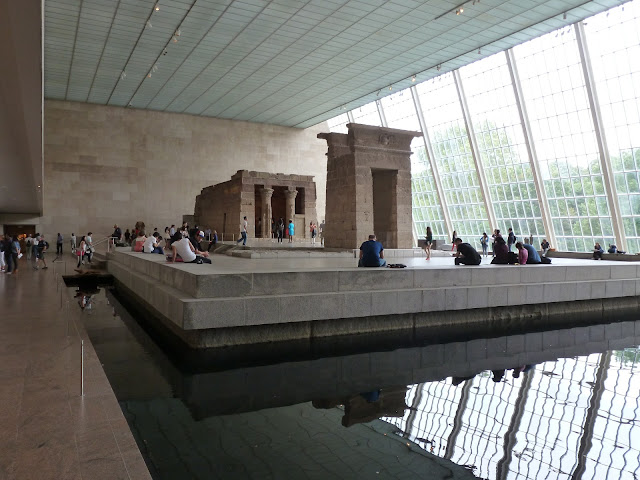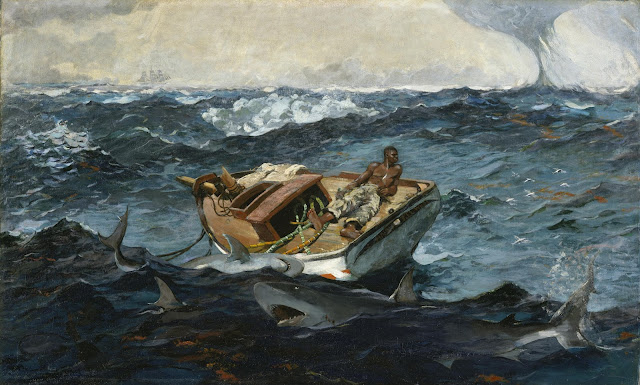Main entrance of the Metropolitan Museum of Art on 5th Avenue and 82nd Street
The Egyptian galleries
The American Wing
The Roman galleries
The Greek corridor
The Petrie Sculpture Court
The 19th century galleries
Everything you see in the Metropolitan Museum is an original work of art, no Times Square copies. These are all the real thing. If you get too close, the guards will remind you.
You can take photos in the museum, as many as you wish of all of the objects. However, no flash is permitted (it damages the artworks). No selfie sticks are allowed either.
Your assignment is to ...
1. Go to the Metropolitan Museum of Art
The Museum is located at 5th Avenue and 82nd Street. The closest subway stop is the 86th street station on the 4,5, and 6 lines.
When you go into the main entrance of the museum, there are ticket booths to the right and left and ahead of you. **You may pay what you wish, but you must pay something if you are a New York City resident. Bring your BCC student ID, or show a driver's license, state ID, or a copy of a bill with your address on it. If you do not have any of these things, you may be charged the full $25 admission to get in. **
More information and a museum map is available at the Museum's website.
2. Pick one work of art from the list below.
3. Write a 3 to 5 page paper, typed, double space, 12 point type. Along with the 3 to 5 pages of text, the paper should include the receipt of your visit (I want to be sure that you saw the original at least once), a Works Cited page, and a picture of the artwork you are writing about. This paper should be presented in a professional quality folder.
Begin your paper by describing the work of art. As you describe it, think about why it looks the way it does. Analyze the artwork. What does the artist want to emphasize in the work of art? What does the artist want you to see first? How can you tell? What role do the secondary parts play? If it is a sculpture, does the artist want us to walk around the statue, or does the artist intend for us to see it from one point of view? How does the artist use materials such as stone, bronze, plastic, color, line, brushstrokes, chisel marks? Is hand work such as brush strokes left visible or is it polished out? What effect do all of these things create?
A lot of these works of art tell stories, played a role in the cultural life of past societies, express religious and spiritual beliefs, or come out of the life experiences and imaginations of particular artists. For this information, you need to do some research. Start with the label next to your work of art in the museum. Then go the Museum website which usually has a lot of additional information on works of art, artists, and cultures. You may want to do further research. The museum has a library that is available to you by appointment. The library staff at the museum gladly helps CUNY students with assignments. Our own library and staff at BCC are available to help you with this project.
Please don't just summarize all of the facts and data that you found in your research. Remember that the point of your paper is to understand and explain the work of art. If basic data such as the birth and death dates of an artist don't really help in understanding the artwork, then they don't belong in the paper.
Selected Works in the Museum for Paper Topics
Pick only one of these.
If you see something in the museum that you want to write about and it's not on this list, then please see me first.
1. The Mastaba Tomb of Perneb, Egyptian galleries
Exterior
Interior
2. The Coffin and Mummy of Khnumhotpe, Egyptian galleries
3. The Tomb Models of Meketre, Egyptian galleries
4. Pharaoh Hatshepsut
There is an entire gallery devoted to Hatshepsut in the Museum's Egyptian galleries. This magnificent statue is the centerpiece.
5. The Coffins and Mummy of Kharushere, Egyptian galleries
You might want to look at the painted imagery on these coffins and see how Egyptian beliefs about the afterlife evolved over time. You could compare these painted images to the imagery in the Tomb of Perneb from several centuries earlier.
6. The Temple of Dendur, Egyptian galleries
A small but complete Egyptian temple in the museum.
7. Storage jar with mountain goats from ancient Iran, Mesopotamian galleries
This is the oldest object in the museum.
8. An Assyrian Lamassu, Mesopotamian galleries
9. Mosaic lion from ancient Babylon, Mesopotamian galleries
This lion is but a small part of a much larger building, parts of which are scattered in museums around the world. The Pergamon Museum in Berlin has the largest surviving section of this same structure.
10. Polykleitos, Diadoumenos, Greek corridor
The Metropolitan Museum owns 3 ancient copies of a once famous work of art. The original no longer exists. Since this is a statue of a victorious athlete, you might want to say something about ancient Greek athletics in your paper to help understand this statue.
11. Bronze statue of a Hellenistic ruler, Greek corridor
Why would a ruler want to have himself shown nude?
12. Etruscan ceremonial chariot, Etruscan gallery on the mezzanine floor of the Roman galleries
13. Roman portrait bust, Roman galleries
There are several others like it in this same gallery.
14. Painted room from an ancient villa, Roman galleries
15. Three painted panels from the same villa showing what may be a wedding
16. The Emperor Caligula, Roman galleries
Both of these Roman Emperors were infamously violent men. Like all rulers and politicians, they were very concerned about their public image. How do each of these busts present an image that each emperor wants us to see? How do they want to influence public opinion?
17. The Emperor Caracalla, Roman galleries
18. Wooden statue of the Virgin Mary and Christ Child from the 12th century, Medieval galleries
19. Claus de Werve, The Virgin and Child, Medieval galleries
20. Jan Van Eyck, Diptych of the Crucifixion and Last Judgment, European Painting galleries
21. Pieter Brueghel the Elder, The Harvesters, European painting galleries
22. Titian, Venus and Adonis, European painting galleries
23. El Greco, View of Toledo, European painting galleries
24. Caravaggio, Peter's Denial, European painting galleries
25. Artemisia Gentilleschi, Esther and Ahasuerus, European painting galleries
26. Peter Paul Rubens, Hunting Wolves and Foxes, European painting galleries
27. Peter Paul Rubens, Lot and His Daughters, European painting galleries
28. Rembrandt, Aristotle Contemplating the Bust of Homer, European painting galleries
29. Rembrandt, Self Portrait, European painting galleries
30, Jan Vermeer, Woman With a Water Jug, European painting galleries
31. Diego Velazquez, Portrait of Juan de Pareja, European painting galleries
32. Elizabeth Vigee-Lebrun, Portrait of the Comtesse de Chatre, European painting galleries
33. Jacques Louis David, The Death of Socrates, European Painting galleries
34. John Constable, Salisbury Cathedral, 19th century galleries
35. JMW Turner, Whalers, 19th century galleries
36. Caspar David Friedrich, Two Men Contemplating the Moon, 19th century galleries
37. Emanuel Leutze, Washington Crossing the Delaware, American wing
38. Albert Bierstadt, The Rocky Mountains, Lander's Peak, Wyoming, American Wing
39. Thomas Eakins, Max Schmidt in a Single Scull, American wing
40. Winslow Homer, The Gulf Stream, American wing
41. Henry Ossawa Tanner, The Flight to Egypt, American wing
42. A face jug by an African American potter, American wing
These were the creations of African American potters in the South. You might not find much on this specific jug, but you might find a lot of information on face jugs and their creators.
43. Mary Cassatt, Young Mother Sewing, American wing
44. Gustave Courbet, Woman with a Parrot, 19th century wing
45. Edouard Manet, Woman with a Parrot, 19th century galleries
If you are writing about this painting, or about the Courbet above, you might consider comparing the two paintings.
46. Edouard Manet, The Boating Party, 19th century galleries
47. Ilya Repin, Portrait of Vsevolod Mikhailovich Garshin, 19th century galleries
48. Claude Monet, La Grenoulliere, 19th century galleries
49. Claude Monet, Poplar Trees in the Evening, 19th century galleries
50. Edgar Degas, The Dance Class, 19th century galleries
51. Paul Gauguin, Ia Oranna Maria, 19th century galleries
What was Paul Gauguin doing in Tahiti?
52. Paul Gauguin, Two Tahitian Women, 19th century galleries
53. Vincent Van Gogh, Wheatfields, 19th century galleries
54. Vincent Van Gogh, L'Arlésienne, Portrait of Madame Ginoux, 19th century galleries
55. Wisteria Dining Room, 19th century galleries
Do you see the influence of paintings like what you see in the 19th century galleries on this room?
56. Jean Baptiste Carpeaux, Ugolino and His Sons, Petrie Sculpture Court
57. Auguste Rodin, The Burghers of Calais, Petrie Sculpture Court
58. Frank Lloyd Wright, Living Room from the Little House, Wayzata, Minnesota, American wing
A room from a house that no longer exists.
59. Pablo Picasso, Portrait of Gertrude Stein, 20th century galleries
60. Pablo Picasso, Still Life with a Bottle of Rum, 20th century galleries
61. Paul Klee, Redgreen and Yellow-Violet Rhythms, 20th century galleries
62. Joan Mio, Animated Landscape, 20th century galleries
63. Arshile Gorky, Water of the Flowery Mill, 20th century galleries
64. Jackson Pollock, Autumn Rhythm, 20th century galleries
65. Norman Wilfred Lewis, untitled, 20th century galleries
A 20th century African American artist whose work was not widely known until recently.
66. Jasper Johns, White Flag, 20th century galleries
When is a flag not a flag?












































































